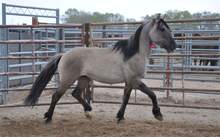Federal land managers, struggling to keep wild horse populations in check on Western range lands, hope contraception will serve as an alternative to the costly and ultimately ineffective practice of warehousing horses for life on private pastures.

A wild stallion in a BLM pen
A proposed study aims to explore what happens when most of a wild herdâs adult male horses are neutered, but horse advocates who generally support fertility control, say the new research proposal targeting a Utah herd for castration goes too far.
© 2015 by BLM
Horse advocates generally support fertility control, but they say a new research proposal targeting a Utah herd for castration goes too far.
The Bureau of Land Management wants to explore what happens when most of a herd's adult males are gelded and is now reviewing a proposed five-year study that would be conducted by the U.S. Geological Survey and Colorado State University. Researchers would neuter wild stallions in the Conger Herd Management Area 70 miles west of Delta, Utah.
Critics say returning neutered males to the range is inhumane and a violation of federal law protecting free-roaming wild horses; a castrated horse no longer behaves like a wild horse and could get sick and lazy, or even die from the procedure. Nor will this research generate useful findings, according to Deniz Bolbol of the American Wild Horse Preservation Campaign.
"Every agency knows you control populations through the females. It's a stupid path they are pursuing," Bolbol said. "If you're not preserving these horses' natural behavior, you're just setting them up for doom."
But, according to BLM spokeswoman Lisa Reid, the research is not limited to population analysis and was prompted by recommendations from the National Academy of Sciences.
"We know that one stud can cover all the mares," she said, noting that the researchers intend to document ecological and behavioral effects of gelding by comparing the Conger with another Utah herd whose stallions will remain intact.
The scoping notice posted for the project last summer, however, describes it as a "population research study." Researchers seek to learn the "effects of removing males from the reproductive population through gelding as an alternative potential management tool," the notice states. "There is no published information on the effects of this on wild horse behavior, range use or whether there would be a measurable impact on population growth."
In 2013, the National Academy of Sciences released a report titled "Using Science to Improve the BLM Wild Horse and Burro Program, A Way Forward," which strongly urged the BLM to rely more on contraception to rein in horse numbers, which far exceed "appropriate management levels" for most herds scattered around the West's high desert range.
Statewide, the horse and burro population exceeds 4,900, more than double what's deemed appropriate. In the absence of predators, herds' populations grow by 18 percent to 25 percent each year, creating conflicts with ranchers whose livestock graze on public lands.
The BLM expects to release a draft Environmental Assessment this week on the Conger project, opening a round of public comment. Advocates insist this project warrants a more thorough Environmental Impact Statement.
Meanwhile, the BLM has released a draft assessment for a burro roundup in the Sinbad HMA west of Green River. About 220 burros inhabit an area that, the BLM says, should have 50 to 70. The agency proposes rounding up 200 and returning 70, leaving 90 animals that then will be the subject of the five-year research project. Radio collars would be affixed to 30 of the burros, whose movements would be tracked.
Advocates do not want wild horses and burros fitted with radio transmitters, because the collars might injure the animals. But the Conger research, which also involves collars, is far more controversial.
While it is standard practice to castrate stallions destined for life in corrals, neutering the ones that remain on the range is seen as an insult to the horses' wildness, a threat to their survival and disruptive to their herds' social structure.
"We believe it's totally illegal to alter what makes a wild horse a wild horse," said Cloud Foundation's Ginger Kathrens.
Bolbol's group teamed with Cloud five years ago to fight a gelding operation targeting a Nevada herd.
"We sued and prevailed. They had to pay our attorney's fees," Bolbol said. "All the research shows that gelded horses have a bigger impact on the range because they don't move around as much."
For the Utah research, the Conger and nearby Frisco herds were selected because they feature similar herd sizes, demographics, habitat and topography â arid mountain ranges surrounded by desert in Utah's West Desert.
